Occupational environment monitoring of a cement manufacturing factory
99,000 ₫
Note: The above price is calculated for one sample, and the price may fluctuate depending on the area of the environment to be monitored and market movements. For more accurate pricing support, please refer to the price list or contact our consulting staff directly.
Monitoring the environment of a cement manufacturing factory is a session of collecting, analyzing, and evaluating factors at the workplace that may harm workers health.
Table of Contents
Toggle1. Overview of the Cement Manufacturing Factory
a. What is a cement manufacturing factory?
Factory manufacturing cement is a production facility that manufactures cement, a common construction material used to create concrete and other construction products. Cement is manufactured by heating main components, including limestone, gravel, and clay, in a kiln at a high temperature of approximately 1450 degrees Celsius to form clinker, which is then ground and mixed with additives to produce the final cement product.
Cement manufacturing factories have many stages and processes to manufacture cement. The manufacturing process may include main steps such as raw material preparation, grinding and mixing, clinker firing, cooling, grinding, and packaging. Each step requires attention and quality control to ensure the final product meets quality standards and regulatory requirements.

b. Manufacturing stages in a cement manufacturing factory
The cement manufacturing process in a cement manufacturing factory includes several main stages as follows:
- Raw material preparation: The main components, including limestone, gravel, and clay, are transported to the factory and stored in raw material warehouses. The materials are then processed and prepared for manufacturing.
- Grinding and mixing: The raw materials are ground into fine particles and mixed in appropriate proportions to create a raw material blend.
- Clinker firing: The raw material blend is fed into a kiln to be heated at high temperatures around 1450 degrees Celsius to produce clinker.
- Cooling: The clinker is rapidly cooled using a cooling machine to reduce its temperature below 100 degrees Celsius.
- Grinding: The clinker is ground into fine cement powder using various types of grinders.
- Packaging: The ground cement powder is packaged into cement bags or sacks for transport and use.

c. Types of machinery used in a cement manufacturing factory
Cement manufacturing factories use various machinery to complete manufacturing stages, including:
- Stone grinder: used to grind limestone and gravel into smaller particles.
- Grinding and mixing machine: to mix raw materials such as limestone, gravel, clay, etc., in appropriate proportions.
- Cement kiln: to heat the raw material mixture at high temperature to produce clinker.
- Cooling machine: to reduce the temperature of clinker after firing.
- Cement grinder: to grind clinker into cement powder.
- Packaging machine: to package cement powder into cement bags or sacks.
- Conveyors and lifting machines: to transport raw materials and products during manufacturing.
These machines are designed for high efficiency and to ensure product quality. In addition, cement manufacturing factories also use inspection and measurement devices to ensure the quality of the final product.

d. Occupational diseases that may occur in cement manufacturing workers
Workers in cement manufacturing factories may encounter the following occupational diseases:
- Cement lung disease: Caused by inhaling cement dust during manufacturing. Symptoms may include pneumonia, coughing, shortness of breath, bronchitis, and other respiratory issues.
- Skin disease from cement exposure: Workers frequently in contact with cement may develop skin problems such as itching, eczema, blistering, and swelling.
- Musculoskeletal disorders: Workers often work in wet, cold, and vibrating environments, which can lead to back pain, joint pain, and joint degeneration.
- Cardiovascular diseases: Many workers are exposed to noisy and hot environments, which may cause high blood pressure, angina, and myocardial infarction.
To prevent these occupational diseases, cement manufacturing factories should implement labor protection measures such as providing protective equipment, ensuring safe work procedures, minimizing exposure to dust and toxic gases, training employees on safety and health, and conducting regular health checkups.

e. Common types of cement on the market
There are many types of cement on the market, depending on composition and manufacturing process. Some common types include:
- Portland cement: The most commonly used cement in construction, concrete, and brick production. It is manufactured by mixing limestone, clay, granite, and iron.
- Refractory cement: Used in high-temperature applications such as kilns, power plants, and other industrial uses. It is manufactured by mixing clay, limestone, and aluminum.
- Aluminate cement: A fast-setting cement used in acid-resistant concrete and other wear-resistant materials.
- Reactive cement: Manufactured by mixing clinker with additives. It is used for self-setting concrete and in civil and industrial construction.
- Low-moisture cement: Designed to reduce drying time and support construction under harsh weather conditions.
- Fiber-reinforced cement: Manufactured by mixing Portland cement with glass or steel fibers, used for fire-resistant and mechanical materials.

2. Overview of workplace environment monitoring services
a. What is workplace environment monitoring at a cement manufacturing factory?
Workplace environment monitoring (or occupational environment assessment) at a cement manufacturing factory is the activity of collecting, evaluating, and analyzing measurements of occupational environmental factors at the factory to implement timely measures, minimize environmental impacts on workers’ health, and prevent occupational diseases. Workplace environment monitoring is a mandatory requirement for cement manufacturing factories.
Workplace environment monitoring plays a critical role in protecting, maintaining, and enhancing workers’ health, as workers are the primary resource of a business and directly contribute to its profit. Workers frequently exposed to risks and occupational hazards beyond permissible limits may experience health issues and develop occupational diseases.
REGISTER FOR WORKPLACE ENVIRONMENT MONITORING SERVICE
b. Nam Viet’s workplace environment monitoring program
Nam Viet’s workplace environment monitoring program is developed by monitoring engineers specializing in occupational safety and environmental protection. Aimed at ensuring workers’ health and safety, this program uses modern measurement methods to monitor air, water, microclimate, physical, and dust factors in the workplace. It is crucial for ensuring a safe working environment and protecting workers’ health.
Additionally, Nam Viet’s program plays an important role in researching and developing new solutions to improve workplace environmental quality. With the dedication and professionalism of the monitoring experts, Nam Viet’s exclusive program is becoming a breakthrough in occupational safety and environmental management in Vietnam.

c. Standardization in workplace environment measurement procedures
Standardization in Nam Viet’s workplace environment measurement procedures is essential for ensuring the quality of measurement results. To guarantee accuracy and reliability, the program follows standards and standardized procedures recognized by the Ho Chi Minh City Department of Health. This ensures that the collected data can be reliably used for evaluating the work environment and making informed decisions to improve workplace conditions and protect workers’ health.
These standardized procedures also ensure that measurements are conducted by a highly qualified team of monitoring specialists with years of experience, enabling managers and experts to trust An Toan Nam Viet’s results and make accurate, valuable decisions to safeguard workers’ health and the environment.
By applying standardization in workplace environment measurement procedures, Nam Viet demonstrates its commitment to ensuring a safe working environment and protecting workers’ health, while contributing positively to the development and enhancement of occupational safety and environmental management in Vietnam.
d. Reporting the results of cement manufacturing factory environment monitoring
Workplace environment monitoring results are compiled according to Form No. 04, Appendix III issued with Decree 44/2016/ND-CP and prepared in two copies: one copy is sent to the enterprise that signed the monitoring contract, and one copy is retained by the organization performing the monitoring.
The retention period for workplace environment monitoring results is indefinite, in accordance with legal regulations.

e. Frequency of workplace environment monitoring as per legal regulations
According to clause 2 of Article 18 of the Law on Occupational Safety and Health 84/2015/QH13, employers must conduct workplace environment monitoring to assess harmful factors at least once a year.
f. Deadline for submitting workplace environment monitoring reports as per legal regulations
The deadline for submitting reports is before December 31 each year. Enterprises at manufacturing facilities are required to submit workplace environment monitoring reports to the Department of Health in the locality where the enterprise’s headquarters is located and where workers are employed.
When there are changes in technology, manufacturing processes, or during facility renovation or upgrades that may generate new harmful factors affecting workers’ health, enterprises must update occupational hygiene records related to these harmful factors and perform workplace environment monitoring.
g. Penalties for violations of workplace environment monitoring by employers
According to Article 27 of Decree No. 12/2022/ND-CP dated January 17, 2022, regulating administrative penalties in labor, social insurance, and Vietnamese workers working abroad under contract:
- Clause 2: Fines from 2,000,000 – 5,000,000 VND for employers who fail to publicly announce to workers at the monitored workplace and at the inspection and management site the results of workplace environment monitoring and the results of inspection, assessment, and management of hazardous factors immediately after obtaining them.
- Clause 3: Fines from 20,000,000 – 40,000,000 VND for employers who fail to conduct workplace environment monitoring to control health impacts on workers as required by law.
- Clause 4: Fines from 40,000,000 – 60,000,000 VND for employers who collude with organizations conducting workplace environment monitoring to commit fraud in monitoring activities, but the act does not yet constitute criminal liability.
3. Harmful environmental factors for workers in cement manufacturing factories
Workers in cement manufacturing factories may be exposed to several harmful environmental factors, including:
- Cement dust: Cement manufacturing usually generates dust, affecting workers’ respiratory systems and potentially causing health problems such as asthma, pneumonia, and lung cancer.
- Smoke and toxic fumes: The clinker burning process in cement manufacturing produces smoke and toxic gases such as carbon dioxide, sulfur dioxide, and nitrogen oxides. Exposure to these substances can cause respiratory problems and sometimes life-threatening conditions.
- Noise: Machinery in cement factories can generate high noise levels, affecting workers’ hearing and potentially causing health issues such as stress and arrhythmia.
- High temperatures: Cement manufacturing produces high temperatures, especially in clinker kilns. Working in such hot environments can lead to health issues such as heatstroke and exhaustion.
- Chemicals: Besides toxic gases, cement production uses various chemicals such as additives, anti-caking agents, and water treatment chemicals. Exposure to these chemicals can cause health problems such as skin irritation, headaches, and nervous system effects.
REGISTER FOR LABOR ENVIRONMENT MONITORING SERVICE
4. Measures to improve the working environment in cement manufacturing factories
Measures to improve the working environment in cement manufacturing factories may include:
- Use of personal protective equipment: Workers in cement factories should be equipped with protective gear such as masks, helmets, gloves, safety shoes, reflective vests, and safety goggles to minimize health risks.
- Workplace improvement: Cement factories should have proper ventilation systems, reduce dust and noise, and enhance natural lighting and green spaces to create a safe and comfortable working environment.
- Employee training: Workers need training to understand safety principles, work procedures, and preventive measures for accidents and occupational diseases.
- Use advanced production equipment: Cement factories should use modern machinery that reduces dust, noise, and other harmful impacts on the working environment.
- Adjust manufacturing processes: Production processes should be modified to minimize worker exposure to harmful chemicals. Additionally, factories should adopt green cement production technologies to reduce environmental and health impacts.
- Periodically conduct labor environment monitoring in factories, collect and analyze harmful factors for workers, and implement adjustments to reduce risks and prevent occupational diseases.
5. Benefits of periodic monitoring in cement manufacturing factories
An Toan Nam Viet provides businesses with excellent benefits when using labor environment monitoring services in accordance with Decree 44/2016/ND-CP on the management and control of harmful factors in the working environment affecting workers.
- Businesses can proactively control harmful factors in workshops or factories.
- Receive advice and recommendations on measures to reduce harmful factors and improve the quality of the working environment.
- Indirectly protect human resources, the key factor in business development.
- Minimize the impact of occupational diseases on human health, reducing future treatment costs.
- Improved worker health leads to higher product quality and consistent production output.
- Compliance with labor safety laws, avoiding legal risks.
- Enhance reputation and professionalism, elevating the business brand.
Nam Viet’s environmental monitoring service is a solution to reduce the impact of occupational diseases, contributing to a clean and high-quality working environment.

6. National labor environment monitoring center
National labor environment monitoring center of Nam Viet is a professional unit specializing in monitoring and measuring labor environment quality across all provinces in Vietnam. With experienced monitoring specialists, the center uses modern measuring equipment to ensure accuracy and reliability.
In addition to monitoring services, the center assists clients in planning, handling, and tracking labor environment issues. With the motto “customer-centered,” the center prioritizes client satisfaction, meets all client needs, and provides the best solutions for businesses.
REGISTER FOR LABOR ENVIRONMENT MONITORING SERVICE
With investment in technology, equipment, and human resources, Nam Viet’s monitoring center has become one of the most reputable units in labor environment monitoring in Ho Chi Minh City, with the following goals:
- We always value our brand reputation and service quality.
- We provide clients with the best and most suitable solutions.
- With a team of experienced Masters and Engineers committed to environmental protection and business benefits.
- Working with Nam Viet Environmental Monitoring, your company will receive professional service from field experts and enjoy the best cost advantages.
The labor environment monitoring process at Nam Viet includes the following steps:
- Before performing monitoring, all equipment is calibrated and adjusted according to legal regulations.
- Follow the complete monitoring procedure as committed to the Department of Health.
- Report labor environment monitoring results honestly to the employer.
- If monitoring results indicate unsafe conditions for workers, Nam Viet will provide corrective solutions, and the workplace will implement:
- Measures to improve working conditions, minimize harmful factor impact, and prevent occupational diseases.
- Organize health checks to detect occupational and related diseases early for employees in unsafe working conditions.
- Provide material compensation to employees according to labor law.

7. Labor environment monitoring price list
To help businesses conduct professional and effective labor environment monitoring, Nam Viet provides clients with a comprehensive and reasonably priced labor environment monitoring service price list.
- Our price list provides detailed information on the costs of monitoring services, including travel, measurement, analysis, and reporting fees. Clients can be assured of the accuracy and reliability of our monitoring reports.
- We are committed to offering the most competitive and reasonable prices on the market and are always ready to provide quick and professional consultation on monitoring services.
- With Nam Viet’s price list, clients can easily choose service packages that meet their needs. We are committed to delivering maximum satisfaction with professional service quality.
No comments yet

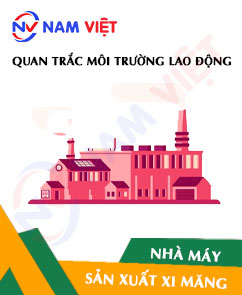
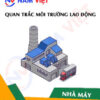
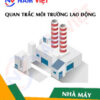
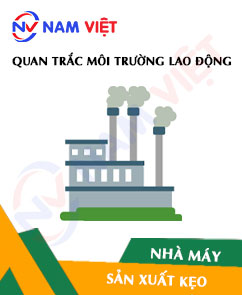



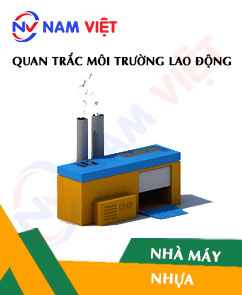
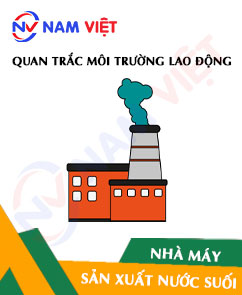


Review Occupational environment monitoring of a cement manufacturing factory
There are no reviews yet.